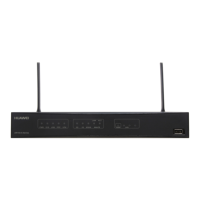By default, correlated alarm suppression is disabled. Therefore, before configuring correlated
alarm suppression, ensure that this function has been enabled.
Step 4 Do as follows to configure correlated alarm suppression or filtering.
l Configure NMS-based correlated alarm suppression.
1. Run the quit command to return to the system view.
2. Run the alarm correlation-suppress enable target-host ip-address securityname
securityname [ vpn-instance vpn-instance-name ] command to configure NMS-based
correlated alarm suppression.
By default, NMS-based correlated alarm suppression is enabled, and thus non-root-cause
alarms are not reported to any NMS. After NMS-based correlated alarm suppression is
disabled, non-root-cause alarms will be reported to the NMS.
– If parameters target-host, securityname securityname, and vpn-instance vpn-instance-
name are configured, the system will not report correlated alarms to the specified NMS.
– If neither of the parameters target-host, securityname securityname, and vpn-
instance vpn-instance-name is configured, the system will not report correlated alarms
to any NMS.
l Configure interface-based alarm filtering.
Run the mask interface interface-type interface-number command to configure interface-
based alarm filtering.
By default, the system does not filter alarms generated on interfaces.
After alarm filtering is configured on an interface, the system does not report the linkup and
linkdown root-cause and non-root-cause alarms generated on the interface to the NMS.
----End
7.3.5 Checking the Configuration
After alarm management is configured, you can check alarm information.
Prerequisites
The configurations of alarm management are complete.
Context
l Run the display alarm active command to check active alarms.
l Run the display alarm history command to check historical alarms.
l Run the display alarm information [ name alarm-name ] command to check alarm
information.
l Run the display this command to check information about delayed alarm reporting.
Example
Run the display alarm active command to view active alarms. For example:
<Huawei> display alarm active
A/B/C/D/E/F/G/H/I/J
A=Sequence, B=RootKindFlag(Independent|RootCause|nonRootCause)
C=Generating time, D=Clearing time
E=ID, F=Name, G=Level, H=State
Huawei AR150&200 Series Enterprise Routers
Configuration Guide - Device Management 7 Fault Management
Issue 02 (2012-03-30) Huawei Proprietary and Confidential
Copyright © Huawei Technologies Co., Ltd.
116

